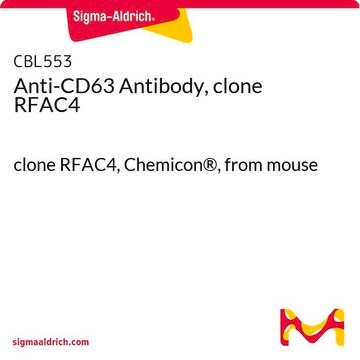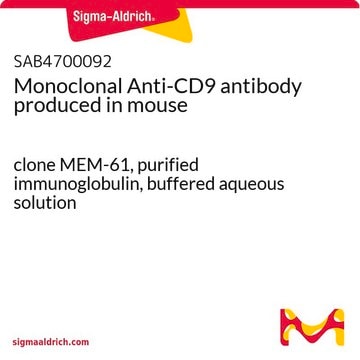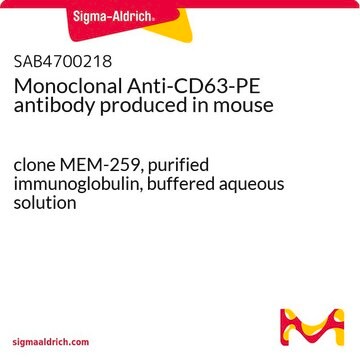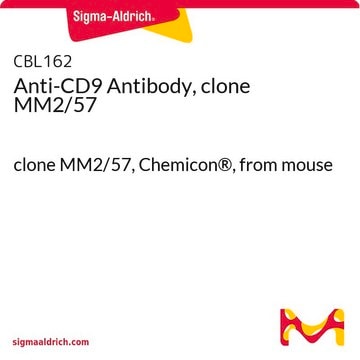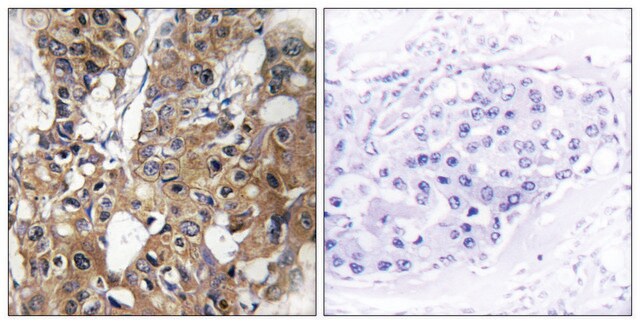SAB4700215
Monoclonal Anti-CD63 antibody produced in mouse
clone MEM-259, purified immunoglobulin, buffered aqueous solution
Iniciar sesiónpara Ver la Fijación de precios por contrato y de la organización
About This Item
Código UNSPSC:
12352203
NACRES:
NA.41
Productos recomendados
origen biológico
mouse
conjugado
unconjugated
forma del anticuerpo
purified immunoglobulin
tipo de anticuerpo
primary antibodies
clon
MEM-259, monoclonal
Formulario
buffered aqueous solution
reactividad de especies
human
concentración
1 mg/mL
técnicas
flow cytometry: suitable
isotipo
IgG1
Nº de acceso NCBI
Nº de acceso UniProt
Condiciones de envío
wet ice
temp. de almacenamiento
2-8°C
modificación del objetivo postraduccional
unmodified
Información sobre el gen
human ... CD63(967)
Categorías relacionadas
Descripción general
Cluster of differentiation 63 (CD63), also known as melanoma 1 antigen, is encoded by the gene mapped to human chromosome 12q13.2. The encoded protein belongs to the transmembrane 4 superfamily (TM4SF). CD63 is an integral membrane glycoprotein expressed in late endosomes and lysosomes and is also present in the platelet dense granule membrane.
The antibody MEM-259 reacts with CD63 (LAMP-3), a 40-60 kDa tetraspan glycoprotein expressed by granulocytes, platelets, T cells, monocytes/macrophages and endothelial cells. Cell surface exposition of CD63 is usually activation-dependent.
Inmunógeno
HPB-ALL T cell line
Aplicación
Monoclonal Anti-CD63 antibody produced in mouse has been used in flow cytometry and confocal imaging.
The reagent is designed for Flow Cytometry analysis. Suggested working dilution for Flow Cytometry is 2 μg/mL of sample. Indicated dilution is recommended starting point for use of this product. Working concentrations should be determined by the investigator.
Acciones bioquímicas o fisiológicas
Cluster of differentiation 63 (CD63) is one of the platelet activation marker, which plays a vital role in platelet aggregation, adhesion to collagen, uptake of oxidized low-density lipoprotein (LDL) in vitro and regulation of angiogenesis. Inadequate expression of CD63 results in the autosomal recessive inherited disorder, Hermansky-Pudlak syndrome. CD63 is associated with various cellular functions, such as cellular adhesion, cell differentiation, migration, carcinogenesis and tumor progression. CD63 is highly expressed in the initial stage of Merkel cell carcinoma and decreased in later stages; therefore, CD63 is considered to be a potential prognostic factor for this malignancy.
Características y beneficios
Evaluate our antibodies with complete peace of mind. If the antibody does not perform in your application, we will issue a full credit or replacement antibody. Learn more.
Forma física
Solution in phosphate buffered saline, pH 7.4, with 15 mM sodium azide.
Cláusula de descargo de responsabilidad
Unless otherwise stated in our catalog or other company documentation accompanying the product(s), our products are intended for research use only and are not to be used for any other purpose, which includes but is not limited to, unauthorized commercial uses, in vitro diagnostic uses, ex vivo or in vivo therapeutic uses or any type of consumption or application to humans or animals.
¿No encuentra el producto adecuado?
Pruebe nuestro Herramienta de selección de productos.
Código de clase de almacenamiento
10 - Combustible liquids
Punto de inflamabilidad (°F)
Not applicable
Punto de inflamabilidad (°C)
Not applicable
Elija entre una de las versiones más recientes:
¿Ya tiene este producto?
Encuentre la documentación para los productos que ha comprado recientemente en la Biblioteca de documentos.
Los clientes también vieron
Tra-Ly Nguyen et al.
Cancer research, 78(18), 5384-5397 (2018-07-29)
The mTOR is a central regulator of cell growth and is highly activated in cancer cells to allow rapid tumor growth. The use of mTOR inhibitors as anticancer therapy has been approved for some types of tumors, albeit with modest
Jayanthi Lea et al.
Oncotarget, 8(9), 14395-14407 (2017-01-26)
There are no suitable screening modalities for ovarian carcinomas (OC) and repeated imaging and CA-125 levels are often needed to triage equivocal ovarian masses. Definitive diagnosis of malignancy, however, can only be established by histologic confirmation. Thus, the ability to
Gene expression signature associated with BRAF mutations in human primary cutaneous melanomas
Kannengiesser C
Molecular Oncology, 1, 425-430 (2008)
The protein CD63 is in platelet dense granules, is deficient in a patient with Hermansky-Pudlak syndrome, and appears identical to granulophysin.
Nishibori M
The Journal of Clinical Investigation, 91, 1775-1782 (1993)
Expression of the tetraspanins CD9, CD37, CD63, and CD151 in Merkel cell carcinoma: strong evidence for a posttranscriptional fine-tuning of CD9 gene expression.
Woegerbauer M
Modern Pathology, 23, 751-762 (2010)
Nuestro equipo de científicos tiene experiencia en todas las áreas de investigación: Ciencias de la vida, Ciencia de los materiales, Síntesis química, Cromatografía, Analítica y muchas otras.
Póngase en contacto con el Servicio técnico

